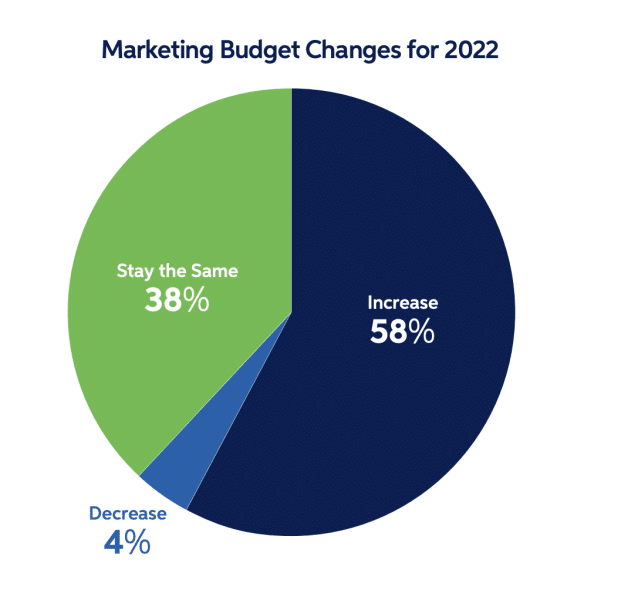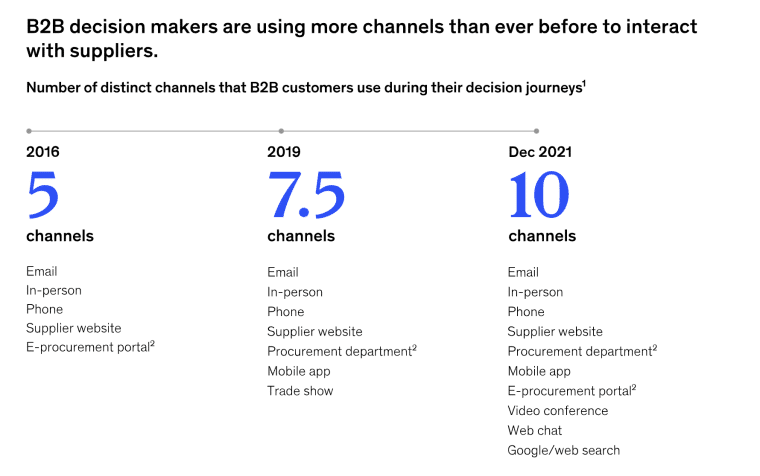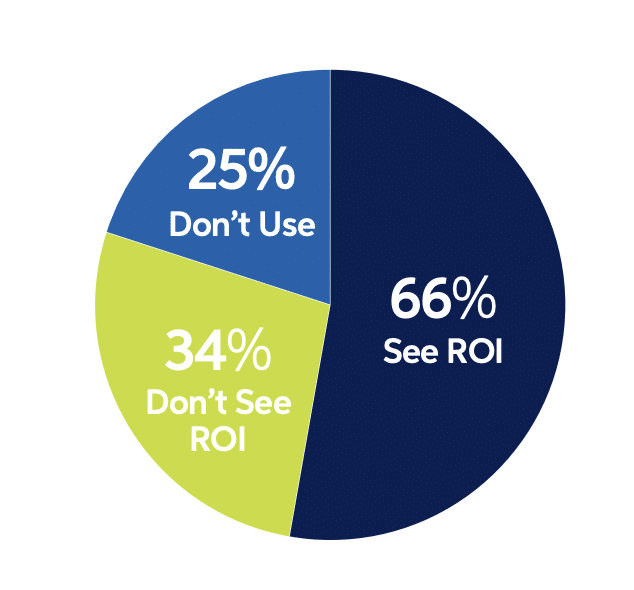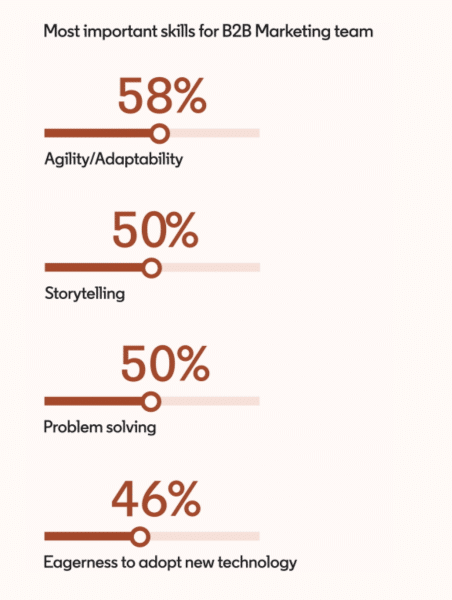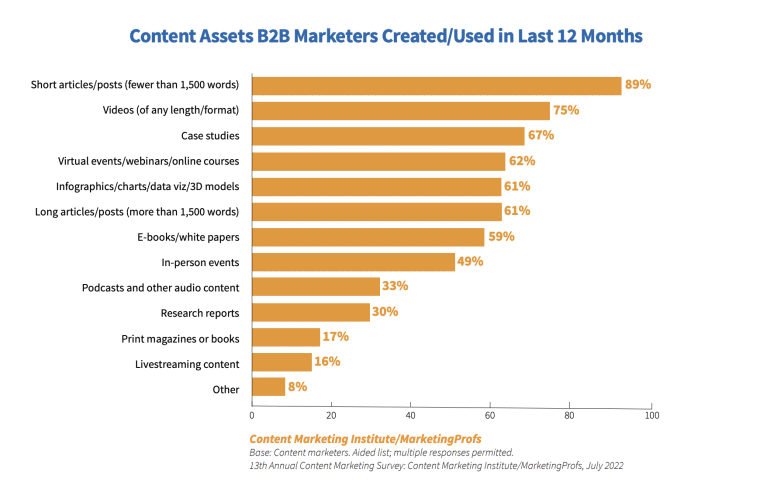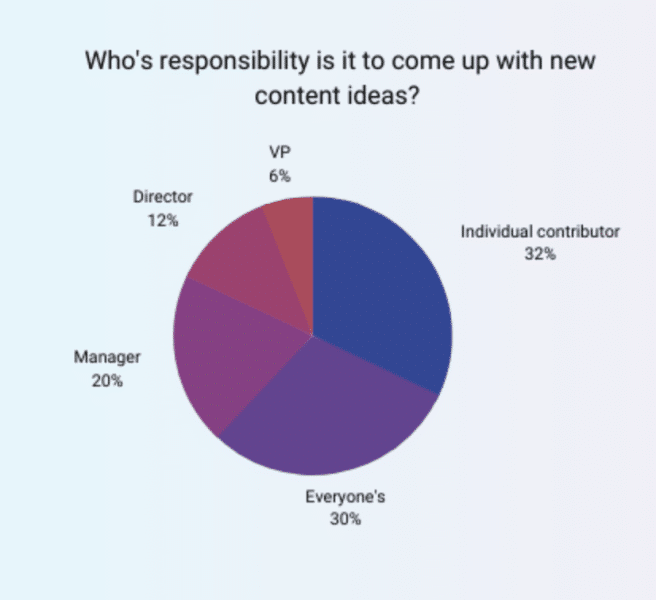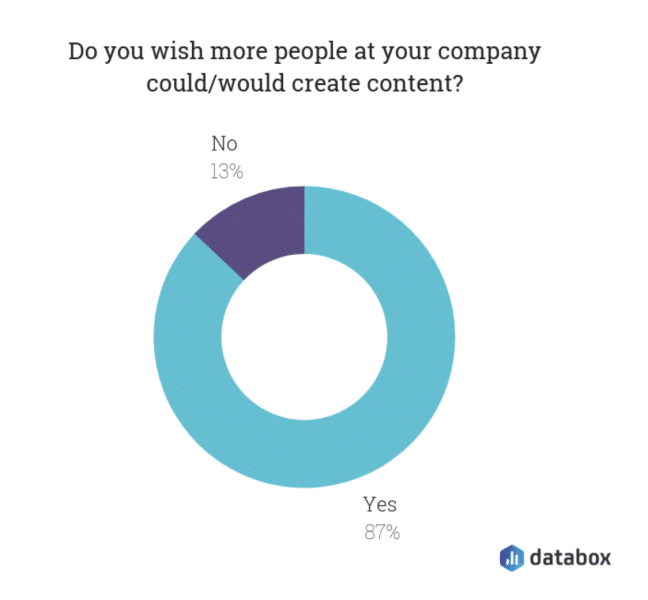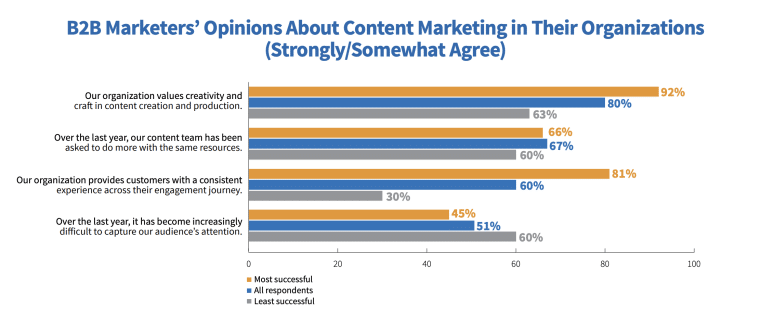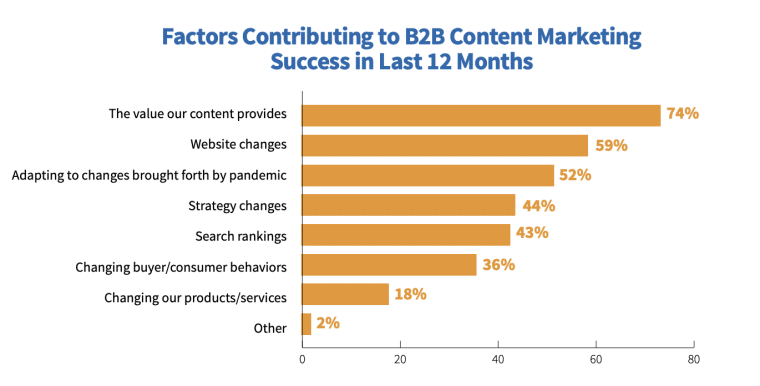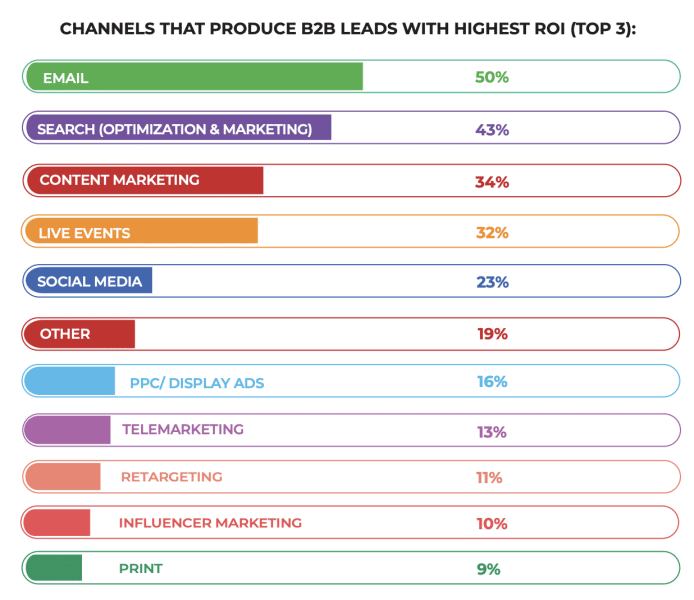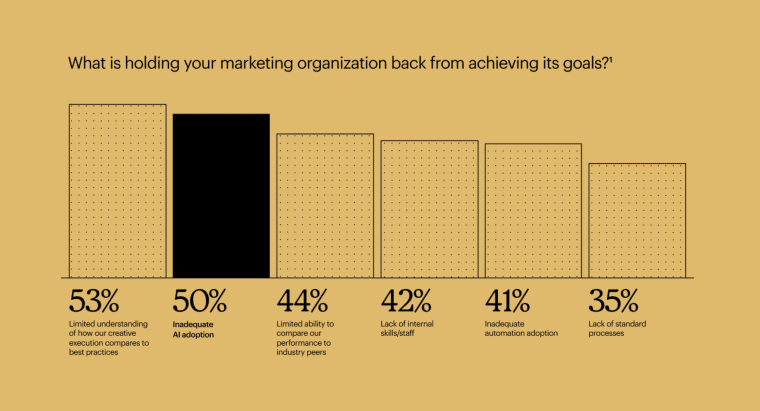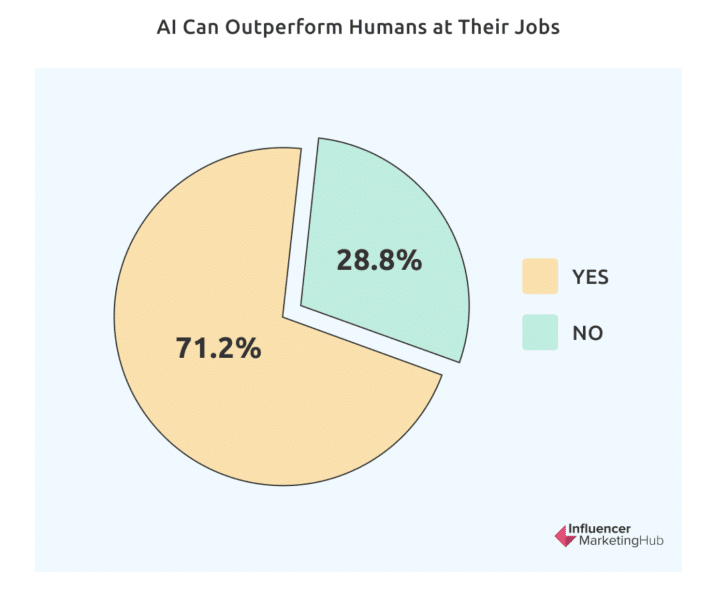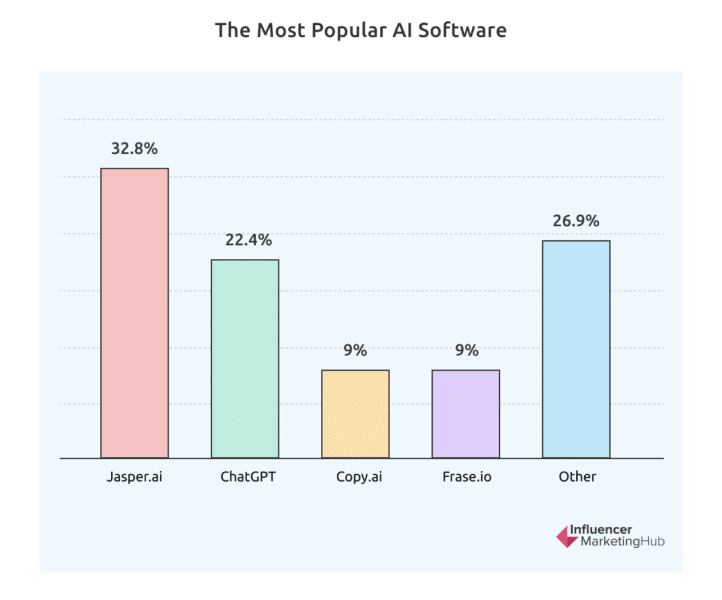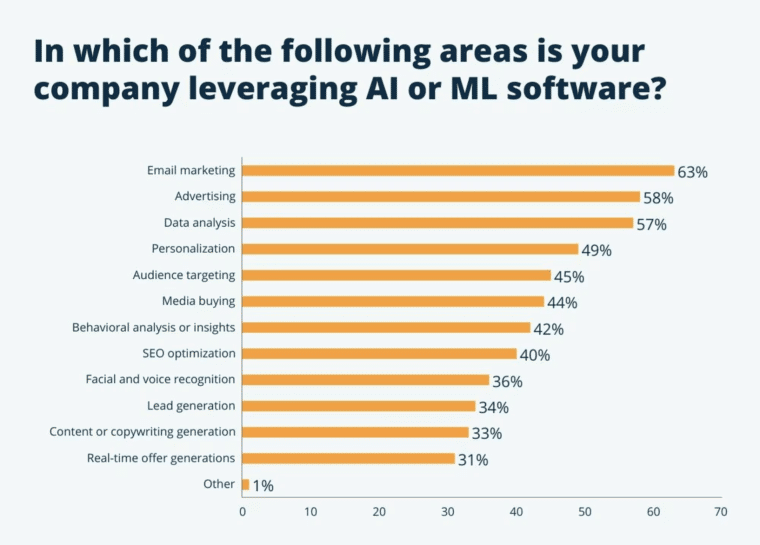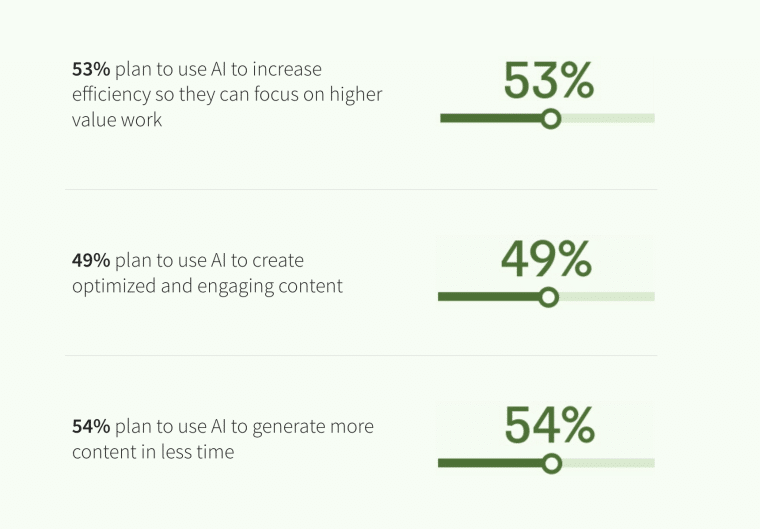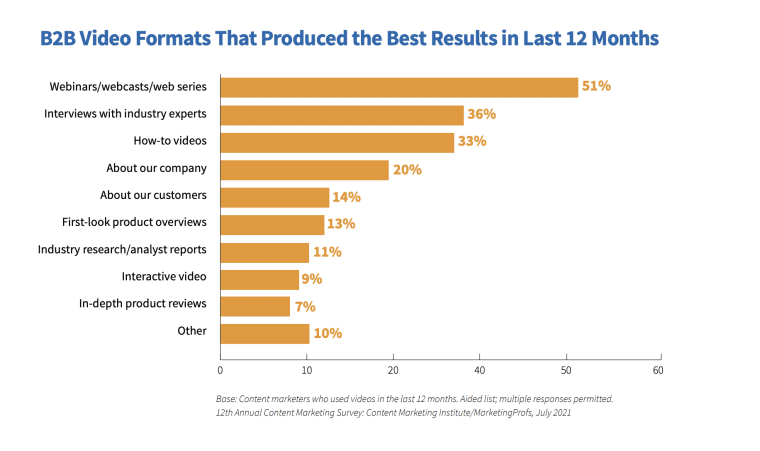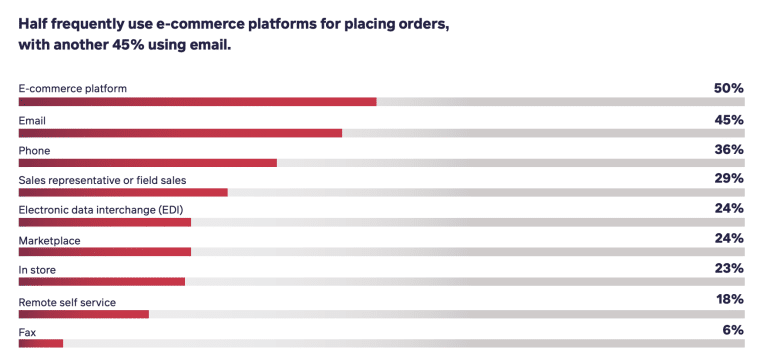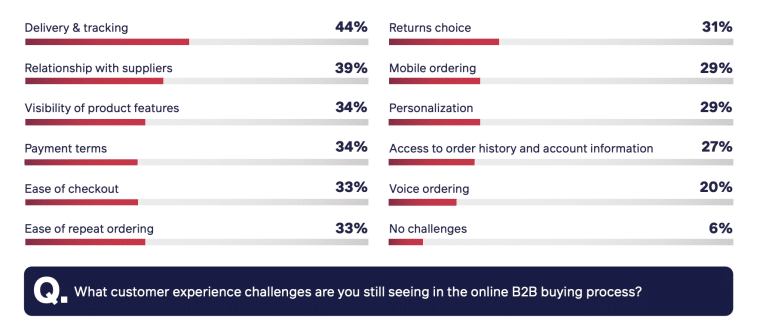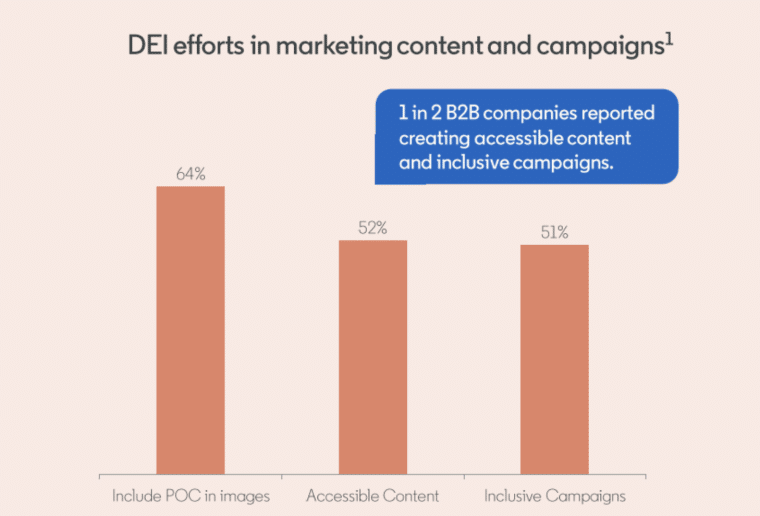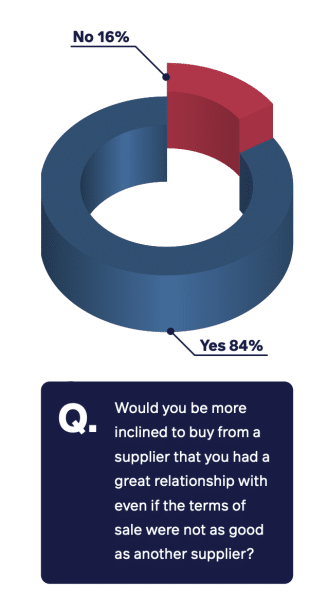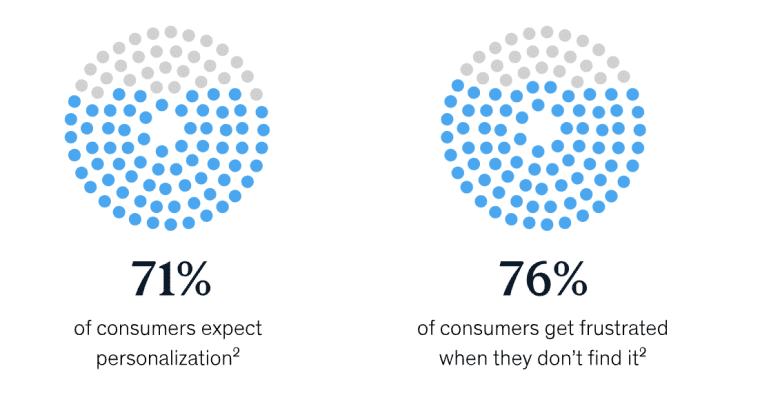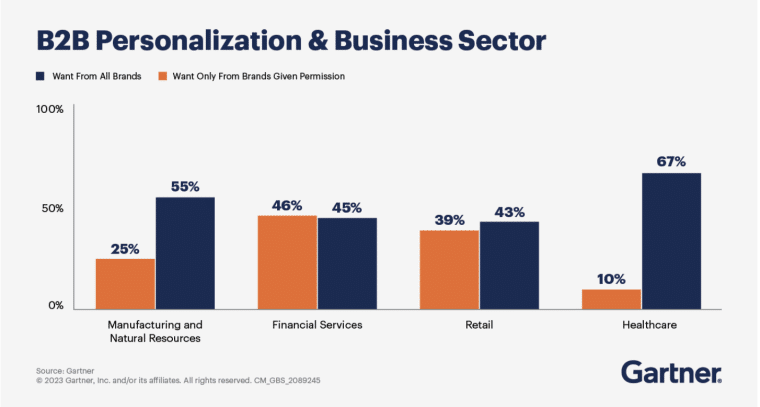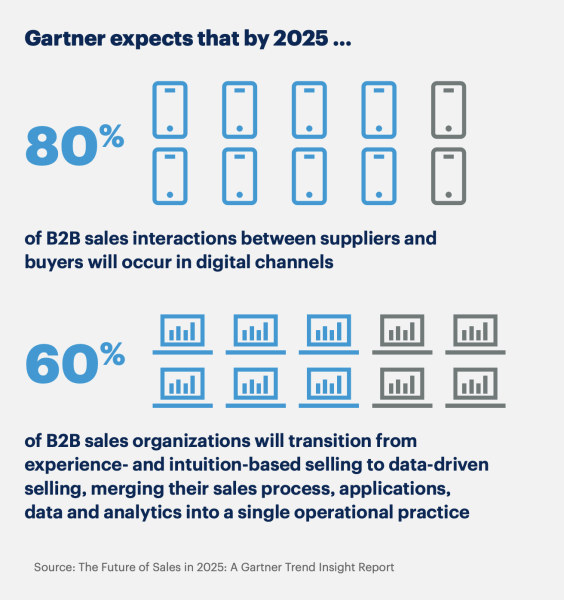The B2B world is incredibly exciting, with new B2B marketing trends constantly emerging as technologies advance and client preferences change. Learning about the growing trends in the industry gives you an edge in formulating the most cost-effective strategy to boost sales and enhance brand recognition.
As an expert in the B2B field, Business2Community is all about sourcing the latest trends that will transform your marketing model. In this article, you’ll find a comprehensive list of key phenomena in B2B marketing so you can follow the money-makers and let your business flourish.
Key B2B Marketing Trends
- In 2016, there were only 5 major B2B channels, which rose to 10 in 2021.
- Social media marketing became a top focus area for businesses as 66% saw desirable ROI in 2022.
- In 2023, 84% of B2B marketers were using analytic tools to keep track of performances and compare benchmarks.
- 51% of marketers put increasing brand awareness as their top priority.
- The use of AI is growing, with 61.4% of marketing strategies using it in 2023.
- 84% of buyers would stay with vendors they had good relationships with, even when the business terms were less attractive.
What are 2025’s B2B Marketing Trends?
Almost every single B2B business relies heavily on intelligent, strategic marketing. A successful B2B marketing strategy brings you new customers and generates long-term profits. Companies are beginning to invest more and more in B2B marketing to maximize profits
According to the 2022 B2B Marketing Mix Report produced by Sagefrog Marketing Group, 58% of companies had increased their marketing budget.
Sana’s 2022 White Paper also revealed that, on average, B2B buyers increased their online spending by 45%.
B2B marketing is vital to business operations in attracting new customers, customer retention, and building a company brand. To stay ahead of the game and maximize your marketing efforts, here are the top digital marketing trends you need to know about.
1. B2B Marketers are Using More Channels Than Ever
Traditionally, B2B marketers relied on only a handful of channels. In 2025, diversifying is a key strategy as clients are no longer using a single form of communication.
According to a 2022 McKinsey report, in 2016, B2B customers were only using 5 major channels during their decision-making process. The number doubled in 2021 to 10 channels. The new channels that emerged during this period were:
- Mobile apps
- Eprocurement portals
- Video conferences
- Webchats
- Search engines
All new channels were related to the digitalization of the B2B market – buyers and sellers began conducting more businesses online.
New companies or decade-old firms that want to expand their sales pool can look into these new and effective channels. Depending on your target audience, some groups are more active on certain channels than others.
2. Social Media Marketing and Influencer Marketing are Great for Gaining Traction
In the current market, B2B marketing is all about meeting your target audience right where they are. Social media marketing strategies can effectively expand your reach and draw in more business customers.
The Safefrog research reported that 66% of B2B professionals saw desirable ROI with social media marketing.
LinkedIn (85%), Facebook (71%), Twitter (now X, 61%), and Instagram (49%) were the most used social media channels in 2022 for B2B. Marketing leaders preferred using these platforms to conduct influencer marketing, connect with local businesses, and network with others in the industry.
Statista estimated the influencer market in general to be worth $21.1 billion in 2023, tripling from its 2019 value.
Many businesses adopt influencer marketing to push out trending content to boost customer engagement. In a B2B context, this can mean working with thought leaders and industry figures to advocate your product and take advantage of their engaged audience, associating your product with their expertise.
3. Google Analytics Remains the Most Popular Tool for Quantifying Marketing Efforts
Marketing analytics provide reliable KPIs for marketing teams to review the latest performances so you can refine your tactics accordingly. By studying the data, decision-makers are more aware of the strengths and shortcomings in the purchase process, the preferences of current customers, the projected reach, etc.
Content Marketing Institute (CMI)’s 2023 research revealed that analytic tools (84%) were the most used technology in the field. Social media scheduling tools (71%) and email marketing software (68%) were also important to monitor different marketing channels.
With nearly 6 million customers in 2023, Google Analytics had a market share of 71.42%, according to 6Sense. Marketing was the top industry in using Google Analytics for business. The data giant was particularly popular among SMEs with 0-49 employees, accounting for 80% of the total market share.
The shift to Google Analytics 4 (GA4), starting with its launch in 2021 and sunsetting of GA3 in 2023, has presented challenges and new opportunities. It gives a different perspective on your website traffic but still offers a way to map your customer journey and quantify your B2B marketing efforts.
4. Connection is All About Storytelling
Establishing a trustworthy figure for your business goes a long way and building brand recognition is a key step in opening up new revenue streams. Customers are more eager to buy from businesses with good reputations.
ViB, a demand gen agency in the tech space, surveyed over 300 B2B marketers in 2023 to shed insights on digital marketing. Over half (51%) of the professionals said their top marketing priority was increasing brand awareness, followed by generating more leads (49%) and improving conversation rates (46%).
In LinkedIn’s B2B Marketing Benchmark report in 2023, 50% of marketers believed storytelling was the most important skill.
Marketers preferred to establish a long-term marketable brand with care, innovation, and ethics in mind. Ethical vendors with a positive public image tended to have more stable clients as people become more conscious about ethical standards in business.
Having a compelling image humanizes your brand and encourages existing customers to stay. It is a long-term marketing strategy that will reap great benefits. Consider telling the stories of your C-suite through video content, creating thought leadership content that shares real-life experiences, and encouraging employee advocacy through offering great benefits.
5. Nothing Beats the Human Touch in B2B
Although a lot of B2B transactions can happen without human involvement, many companies are still in favor of fostering genuine and authentic connections.
In the CMI survey, 95% of marketers believed having some form of human interaction benefited their businesses, with 48% favoring in-person business events and 47% favoring virtual events such as webinars and online conferences.
By attending industry events, B2B professionals can share insights, form partnerships, promote their brands, etc. Meeting other business leaders in formal events also builds more credibility, compared to cold calling and other traditional channels.
6. Companies Need to Value Individual Creative Input During the B2B Process
A decade ago, the responsibility of content creation fell onto the senior members of a marketing team. But now, companies are valuing individual input to foster creativity and uniqueness.
In 2023, Databox surveyed marketers, business leaders, and other employees to understand the content marketing process. 32% of respondents stated that it was the individual contributor’s responsibility for new content ideas while 30% voted it to be “everyone’s”.
A further 87% wished more people in their companies would contribute to marketing campaigns to improve quality and productivity.
The findings resonate with the Content Marketing Institute’s 2022 B2B Content Marketing Report. In the report, 92% of marketers said organizations that valued their creativity and B2B marketing strategies contributed greatly to success.
74% also believed their high-quality content played a significant role in marketing success, followed by website changes (59%)
Overall, companies that allow creative freedom from individual team members will see more successful marketing processes. They can create content that achieves marketing goals more easily.
7. Email Marketing Remains a Hot Marketing Strategy
Email marketing is one of the oldest marketing strategies – nearly as old as the internet itself – and in 2025, it remains one of the hottest digital marketing trends for B2B.
In Litmus’ 2021 State of Email Marketing Report, 41.5% of B2B marketers said email marketing was vital to their businesses’ success. The same research estimated that email ROI was 36:1 in 2021.

According to the 2020 Chief Marketer B2B Survey, B2B marketing professionals believed email (50%) generated the highest-quality leads, followed by search engine optimization (SEO) marketing (43%), and content marketing (34%)
Email segmentation works for businesses, according to DMA. It brought ROI up 760% compared to non-segmented content. Through segmentation, your business can form a deeper bond with your target audience and generate more leads with a more specific and targeted message.
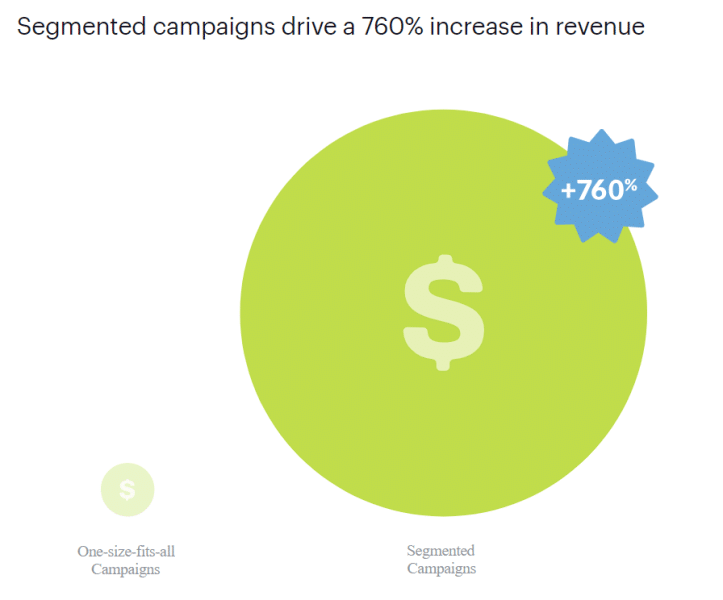
8. B2B Marketers are Using Artificial Intelligence to Boost Performance
In 2025, artificial intelligence continues to play a huge part in current marketing trends.
A 2023 MailChimp survey found that 50% of B2B marketers thought inadequate AI adoption was the reason holding back their businesses.
In the Artificial Intelligence (AI) Marketing Benchmark Report: 2023 produced by Influencer Marketing Hub, 61.4% of B2B marketing professionals said they used AI in their marketing campaigns. 71.2% even thought AI could outperform humans.
The most popular AI tools were Jasper.ai (32.8%) and ChatGPT (22.4%). Companies were utilizing these tools to customize content marketing campaigns, deliver personalized content, polish brand image, and curate professional invitations to other businesses.
A 2022 Capterra survey reported the top areas for AI adoption were:
- Email marketing (63%)
- Advertising (58%)
- Data analysis (57%)
- Personalization (49%)
AI was being widely used to meet marketing needs. Through machine learning, it can create content for each segmented target market, conduct marketing analytics, send feedback to marketing teams, identify the latest trends, and more.
A 2023 LinkedIn report stated that half of the B2B marketers surveyed planned to adopt AI extensively to create optimized content for search engines (49%), generate quality content within a shorter time frame (54%), and free up human team members for other complicated tasks (53%).
The Hootsuite Social Trends 2024 Survey also revealed a 318% increase in using AI in customer support during the B2B process among companies.
Businesses believed AI could provide more reliable and timely support without geographical constraints. Certain AI technologies can even handle language translations in real-time, offering care to global clients in different language regions.
However, some consumers were not overly keen on AI taking over the whole B2B content marketing process as 62% of respondents expressed concerns and doubts about completely AI-generated content. Most customers still wanted the human touch during the buying process for better authenticity and trustworthiness.
While AI is unlikely to replace all B2B human efforts in the foreseeable future, decision-makers are valuing new technologies more and integrating them better into their sales processes to enhance sales and deliver a better consumer experience.
9. Video is the Most Popular Content Type
Reels and short-form videos are a hot element of content marketing strategy in 2025. Consumers respond positively to engaging video content about products and services they are interested in.
The same Chief Marketer survey we looked at earlier showed that video content (61%) gathered the best response from audiences. Videos offer an immersive customer experience and deliver better product overviews.
Consumers also found links to websites (51%) and blog posts (43%) useful. Companies with dedicated blog posts about their products/services tended to perform better in lead generation. They were more effective in increasing brand awareness as well.
The most used B2B video types were:
- Webcasts (51%)
- Interviews with industry experts (36%)
- Instruction videos (33%)
- Company information (20%)
When your business is ready to scale, creating video content about your products as well as positioning your business as an industry leader with a series of videos can push your brand front of mind to your buyers.
10. B2B Buyers are Relying on Smooth Ecommerce Platforms for Purchases
Everything is getting digitalized in 2025, including the entire B2B marketing process. Having a stunning UX design captures the attention of potential buyers, encouraging them to purchase from you rather than look elsewhere.
In the same Sana survey, most buyers used ecommerce platforms (50%) to place orders, followed by email (45%) and phone (36%). A functional, easy-to-use website allowed them to make purchases without hassle, boosting sales and satisfaction rates.
The 2023 GoodFirms Research Report stated that slow loading time (88.5%) and non-responsive websites (73.1%) were the two main reasons for buyers to abandon a site visit. Customers who left were unlikely to return to the same shop through other means.
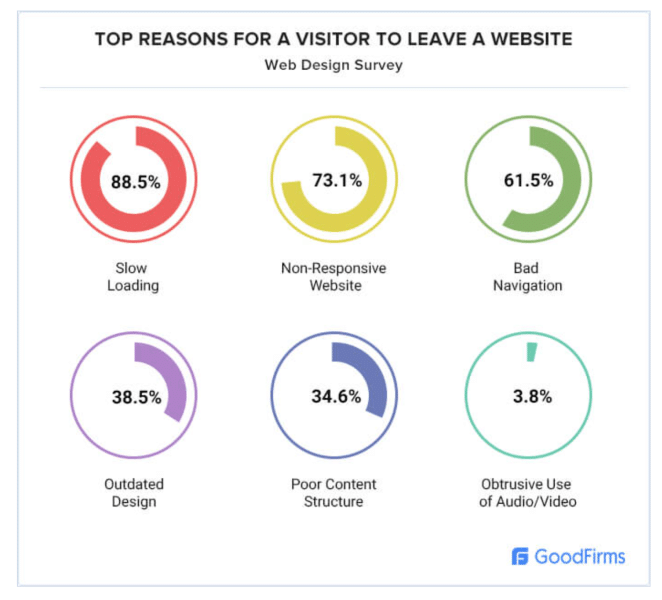
A seamless buying experience includes a stress-free delivery and tracking process, which many suppliers lacked, as the Sana 2022 B2B Buyer Report stated.
44% of ecommerce platforms struggled with delivery and tracking issues. The root cause was an incomprehensible system setup and unclear site layout. Most companies outsourced the delivery process to outside firms, meaning the lack of proper communication also led to customers feeling lost about shipment due dates and conditions.
Not having clear payment terms (34%) and the ease of purchase (33%) and re-purchases (33%) also contributed to sales loss. Companies need to instill confidence in customers to stimulate sales.
To avoid customers jumping over to other businesses, firms can conduct regular website speed tests, accessibility testing, and introduce more interactive elements to gain users’ attention. Buyers are more willing to buy from vendors with a memorable and efficient platform.
11. B2B Marketers Want to Run Inclusive Campaigns
As the world fights to build a more inclusive environment for all, B2B marketers have to consider accessibility issues to gain consumers’ trust. Diversity, equity, and inclusion (DEI) is a growing trend to pay attention to.
LinkedIn reported that 1 in 2 B2B companies have created accessible content as part of their marketing strategy. Common DEI initiatives included alt text on images, voice search assist, low contrast layouts, and minimizing the use of animation and incorrectly formatted tables.
Companies that ran inclusive campaigns drew a larger audience base and established a good social reputation. Disabled people can purchase from accessible websites more conveniently while the general public responde better to brands with accessible features.
12. Nurturing Relationships with Existing Customers Generates Long-Term Sales
Retention marketing is a big topic in the B2B world. Executing the right strategy can generate stable streams of income from your existing customers. 81% of businesses agreed that having good relationships with the vendor is important in the buying process.
A further 84% expressed willingness to continue buying from vendors they had good relationships with, even when the terms of business were not as preferential.
Considering the costs of research and the risk of getting in touch with new sellers, most buyers would rather stay for convenience because they felt safe with their current vendors.
To nurture relationships with your customers, offering regular discounts, ensuring timely deliveries, and quality-checking different batches periodically are some basic methods to take on in your production process.
13. B2B Buyers Want More Personalization
Personalized content offers an intimate touch, closing the gap between your company and the client. Customers expect personalization in B2B so they can get the most suitable products/services recommended to them whenever they browse.
According to McKinsey’s Next in Personalization 2021 Report, 71% of shoppers expected personalization during the shopping process and 76% would even get frustrated if the vendor didn’t offer personalized experiences.
Businesses that offered personalization at every stage were much more likely to thrive.
B2B giants like Amazon, FedEx, MailChimp, and WeWork all utilize personalization to promote specific services to clients, allowing potential buyers to find products they’re interested in without having to manually browse through the entire site.
A 2023 Gartner research found that regardless of the sectors, clients still preferred personalization. The healthcare sector stood out with 67% of respondents expressing desire for personalization. Having a thoroughly curated shopping experience gave buyers confidence in the brand and the product.
Consumers were also more willing to consider repurchasing from vendors that personalized as they could discover relevant products more easily.
Whether you offer a single service or have your toes dipped in several fields, personalization is the best way to bring up efficiency and customer satisfaction rates.
How to Find B2B Marketing Trends
B2B marketing is a dynamic world with fresh, emerging trends. If you want to keep your business mind sharp, you have to check for the latest trends frequently. Here are a few of the best channels to continue to find B2B marketing trends in 2025.
1. Company Surveys and Reports
Consulting firms and marketing giants like McKinsey and the Content Marketing Institute publish annual reports and regular surveys to understand the current B2B landscape. These leading firms provide valuable information about key business trends that can be a major game changer to your operations.
From personalized experiences to voice search technologies, subscribing to their newsletters ensures timely updates straight to your inbox. Reading their latest analytic piece is an excellent way to learn about industry news before your morning meetings every day.
2. Podcasts
Podcasts are a fun, yet equally informative, channel to hear about the hottest B2B lead generation methods.
The Business Growth Show – B2B Marketing & Demand Generation Podcast hosted by industry expert Sam Dunning is a weekly show that discusses feasible B2B solutions for business owners and marketers with a particular focus on SMEs.
The show uses real-world examples to put textbook theories into actionable steps. Whether you’re curious about data analytics or affordable ways to expand your social network, this show covers all the important topics.
3. In-Person or Virtual Industry Events
Meeting like-minded professionals is possibly the best way to widen your horizon about the evergreen B2B marketing world. Each year, there are dozens of in-person and virtual industry events for experts in the field to meet and greet.
For example, the B2B Marketing EXPO in London had 70+ speakers and well over 6,000 attendees to share their thoughts on effective marketing channels, data privacy, AI, and more.
Some conferences shed light on niche-specific trends. The Social Next Virtual Summit organized online conferences to talk about how customers were using social media these days so more companies could reap profits from smartphone users.
By joining these events, you can to chat with decision-makers face-to-face. It is a wonderful way to expand your social network in the B2B field as well.
The Future of B2B Marketing
In the B2B space, stakeholders must make accurate projections about its growth to stay ahead.
The 2020 Gartner’s Future of Sales: Transformational Strategies for B2B Sales Organizations REPORT estimated that, by 2025, 80% of B2B sales will happen through digital channels, reducing time and geographical constraints for buyers and suppliers.
The report also predicted that 60% of B2B companies will move to data-driven selling, combining their sales process, data integration steps, and applications into a single operation.
Here’s a summary of the key trends and takeaways to keep an eye on in 2025 and beyond:
- AI will be more involved in marketing analytics to deliver instant feedback to marketing teams.
- More companies will continue to focus on personalization.
- Firms will emphasize brand recognition and storytelling to appeal to a wider audience.
- Businesses will invest more in influencer marketing and social media promotions.
- Web accessibility features like voice search, image alt texts, and contrast sensitivity customization will be highlighted in the future of content development.
